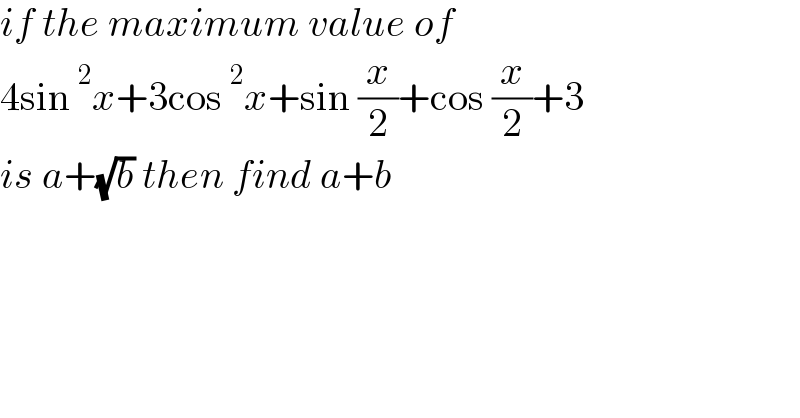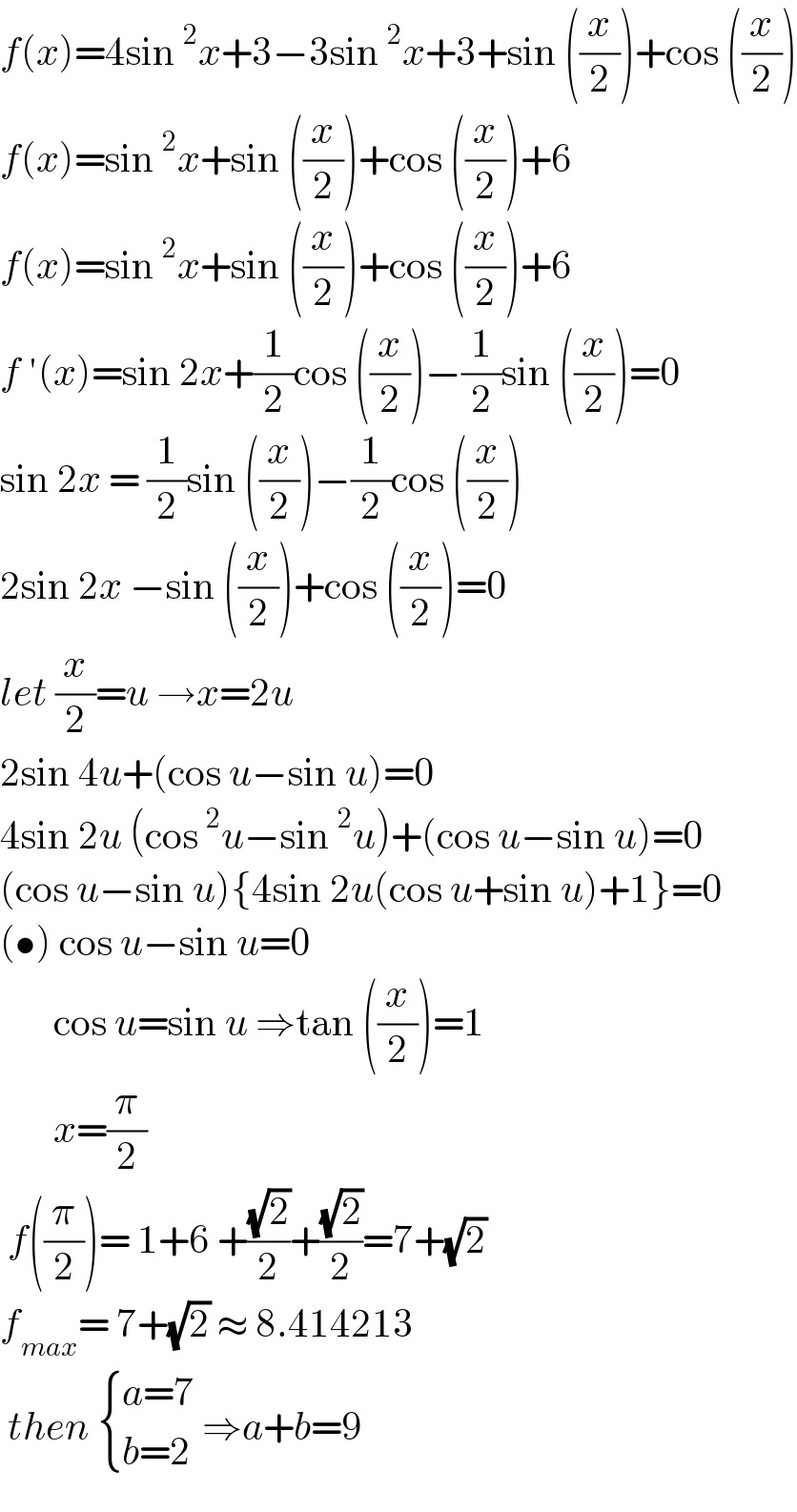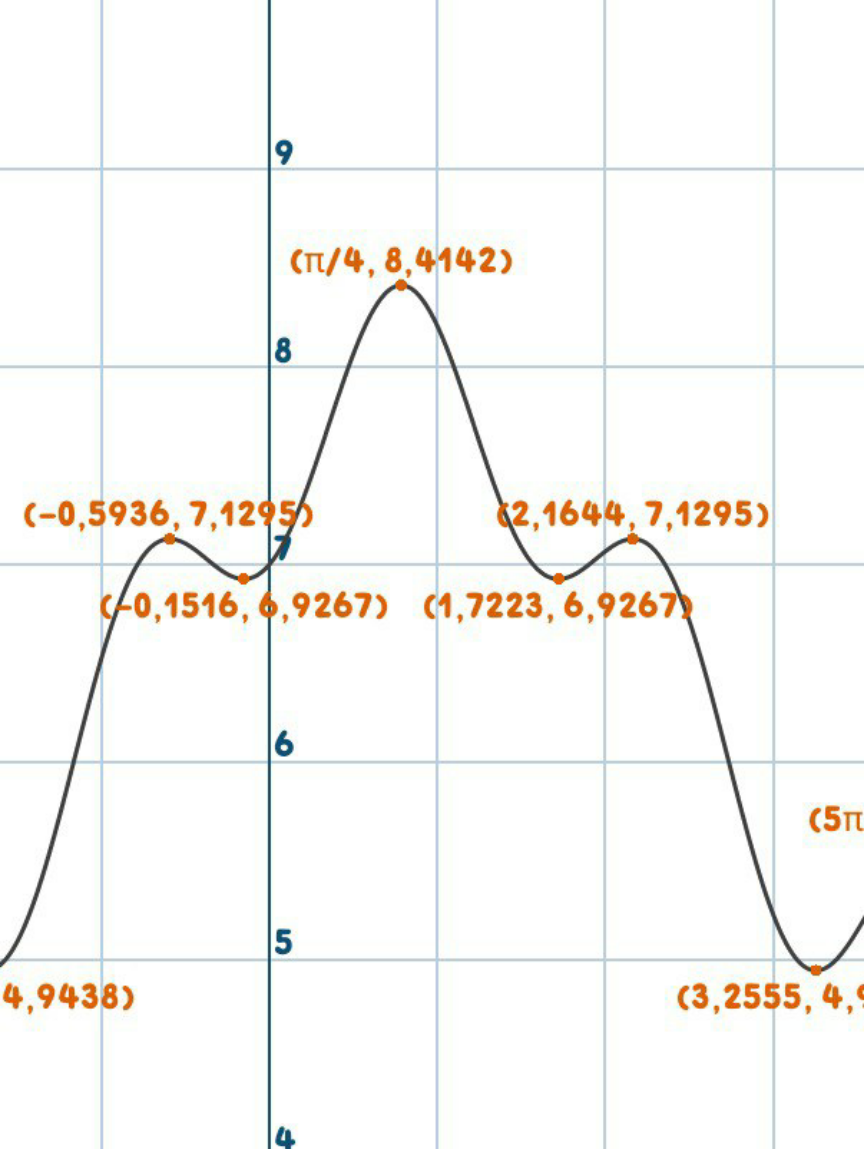Question Number 146876 by gsk2684 last updated on 16/Jul/21

$${if}\:{the}\:{maximum}\:{value}\:{of}\: \\ $$$$\mathrm{4sin}\:^{\mathrm{2}} {x}+\mathrm{3cos}\:^{\mathrm{2}} {x}+\mathrm{sin}\:\frac{{x}}{\mathrm{2}}+\mathrm{cos}\:\frac{{x}}{\mathrm{2}}+\mathrm{3} \\ $$$${is}\:{a}+\sqrt{{b}}\:{then}\:{find}\:{a}+{b} \\ $$
Answered by liberty last updated on 16/Jul/21

$${f}\left({x}\right)=\mathrm{4sin}\:^{\mathrm{2}} {x}+\mathrm{3}−\mathrm{3sin}\:^{\mathrm{2}} {x}+\mathrm{3}+\mathrm{sin}\:\left(\frac{{x}}{\mathrm{2}}\right)+\mathrm{cos}\:\left(\frac{{x}}{\mathrm{2}}\right) \\ $$$${f}\left({x}\right)=\mathrm{sin}\:^{\mathrm{2}} {x}+\mathrm{sin}\:\left(\frac{{x}}{\mathrm{2}}\right)+\mathrm{cos}\:\left(\frac{{x}}{\mathrm{2}}\right)+\mathrm{6} \\ $$$${f}\left({x}\right)=\mathrm{sin}\:^{\mathrm{2}} {x}+\mathrm{sin}\:\left(\frac{{x}}{\mathrm{2}}\right)+\mathrm{cos}\:\left(\frac{{x}}{\mathrm{2}}\right)+\mathrm{6} \\ $$$${f}\:'\left({x}\right)=\mathrm{sin}\:\mathrm{2}{x}+\frac{\mathrm{1}}{\mathrm{2}}\mathrm{cos}\:\left(\frac{{x}}{\mathrm{2}}\right)−\frac{\mathrm{1}}{\mathrm{2}}\mathrm{sin}\:\left(\frac{{x}}{\mathrm{2}}\right)=\mathrm{0} \\ $$$$\mathrm{sin}\:\mathrm{2}{x}\:=\:\frac{\mathrm{1}}{\mathrm{2}}\mathrm{sin}\:\left(\frac{{x}}{\mathrm{2}}\right)−\frac{\mathrm{1}}{\mathrm{2}}\mathrm{cos}\:\left(\frac{{x}}{\mathrm{2}}\right) \\ $$$$\mathrm{2sin}\:\mathrm{2}{x}\:−\mathrm{sin}\:\left(\frac{{x}}{\mathrm{2}}\right)+\mathrm{cos}\:\left(\frac{{x}}{\mathrm{2}}\right)=\mathrm{0} \\ $$$${let}\:\frac{{x}}{\mathrm{2}}={u}\:\rightarrow{x}=\mathrm{2}{u} \\ $$$$\mathrm{2sin}\:\mathrm{4}{u}+\left(\mathrm{cos}\:{u}−\mathrm{sin}\:{u}\right)=\mathrm{0} \\ $$$$\mathrm{4sin}\:\mathrm{2}{u}\:\left(\mathrm{cos}\:^{\mathrm{2}} {u}−\mathrm{sin}\:^{\mathrm{2}} {u}\right)+\left(\mathrm{cos}\:{u}−\mathrm{sin}\:{u}\right)=\mathrm{0} \\ $$$$\left(\mathrm{cos}\:{u}−\mathrm{sin}\:{u}\right)\left\{\mathrm{4sin}\:\mathrm{2}{u}\left(\mathrm{cos}\:{u}+\mathrm{sin}\:{u}\right)+\mathrm{1}\right\}=\mathrm{0} \\ $$$$\left(\bullet\right)\:\mathrm{cos}\:{u}−\mathrm{sin}\:{u}=\mathrm{0} \\ $$$$\:\:\:\:\:\:\:\mathrm{cos}\:{u}=\mathrm{sin}\:{u}\:\Rightarrow\mathrm{tan}\:\left(\frac{{x}}{\mathrm{2}}\right)=\mathrm{1} \\ $$$$\:\:\:\:\:\:\:{x}=\frac{\pi}{\mathrm{2}} \\ $$$$\:{f}\left(\frac{\pi}{\mathrm{2}}\right)=\:\mathrm{1}+\mathrm{6}\:+\frac{\sqrt{\mathrm{2}}}{\mathrm{2}}+\frac{\sqrt{\mathrm{2}}}{\mathrm{2}}=\mathrm{7}+\sqrt{\mathrm{2}} \\ $$$${f}_{{max}} =\:\mathrm{7}+\sqrt{\mathrm{2}}\:\approx\:\mathrm{8}.\mathrm{414213} \\ $$$$\:{then}\:\begin{cases}{{a}=\mathrm{7}}\\{{b}=\mathrm{2}}\end{cases}\:\Rightarrow{a}+{b}=\mathrm{9} \\ $$
Commented by gsk2684 last updated on 16/Jul/21

$${thank}\:{you}\: \\ $$
Commented by liberty last updated on 16/Jul/21

